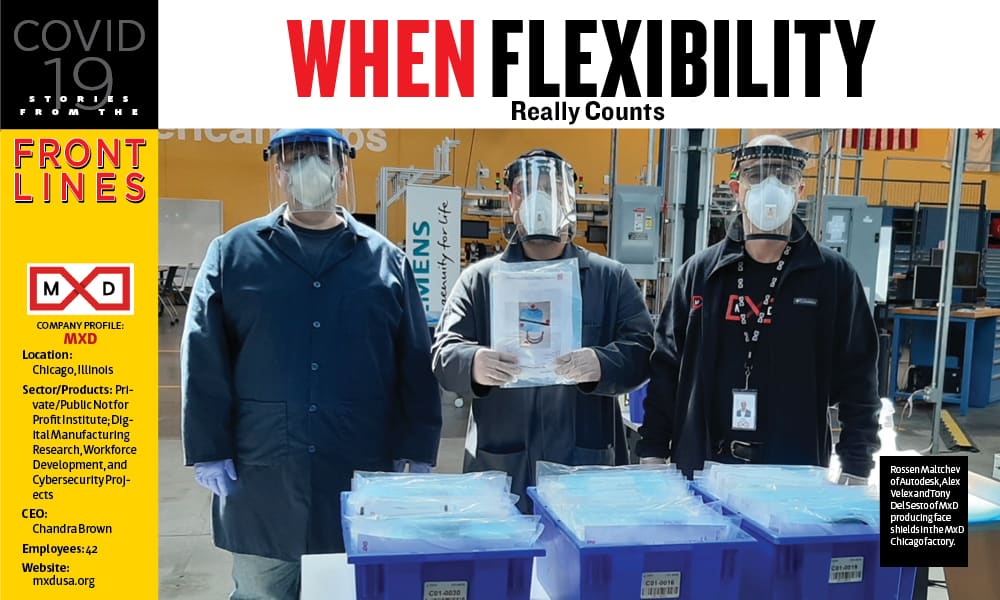
MxD, a partnership with the Department of Defense, addressed the urgent need for face shields by employing digital manufacturing techniques, crowdsourcing, and its manufacturing ecosystem.
When people hear the term digital manufacturing, several concepts like Industry 4.0, IIOT, and data analytics come to mind. If you do an internet search on the benefits of this technology, you will find things like improved throughput, less downtime, and lower costs – all good things.
However, there is one term often overlooked when discussing digital manufacturing. That is flexibility.
Let’s face it, efficiency and flexibility aren’t always the best of friends in the world of manufacturing. Yet, it is flexibility that becomes critical when a crisis forces rapid change. Covid-19 has certainly created such a crisis.
In Chicago, where the MxD facility is located, local hospitals were making public pleas for personal protection equipment. We knew we could help. Our Goose Island research factory is not set up for production. Our efforts are normally focused on digital R&D projects, cybersecurity, and workforce development.
However, as The Digital Manufacturing Institute, we knew MxD could act quickly. We could design, build, test, and manufacture something in a matter of days. After reviewing the requests from local hospitals, we decided to make face shields.
Crowdsourcing the Design
Our initial reaction was to make a unique design. At MxD, we have mechanical design capability and some of the best available computer-aided design tools. However, we do look at everything through a digital lens, and digital technology had already enabled an amazing design tool: Crowdsourcing.
Sure enough, a quick search on the internet identified scores of teams worldwide with open, crowdsourced designs in development.
We eventually settled on a design we liked due to its maturity and robustness. It could accept heavy shield material, could be disinfected and reused, and more closely resembled shields healthcare workers were used to wearing. Now, we just needed to make them.
The face shield consisted of an upper frame, lower frame, elastic headband, rubber pads, and the clear shield material. Our challenge was sourcing the clear PETG raw material for the shield. We bought whatever we could get our hands on and expedited delivery.
The material would arrive at MxD in three days. So we had three days to prepare everything else.

One of the key production challenges was dealing with different types of additive equipment.
Autodesk, Siemens Step Up
At MxD, we also have the benefit of hosting a large manufacturing ecosystem. With nearly 300 members, our Institute has access to a wealth of experience and resources with which to partner.
Two of those members, Autodesk and Siemens, had manufacturing equipment consigned on our factory floor which was suitable to make face shield components. Both members enthusiastically offered their equipment and personnel to join our efforts. In addition, MxD had several pieces of equipment ready to go. However, there was a problem. We all had different types of equipment using different technology. Here is where digital technology, and the convergence of standards, really shines.
Siemens had an additive machine using fused deposition modeling (FDM). Autodesk had one using selective laser sintering (SLS). MxD had two machines using FDM. Both were different brands. So now we had four different brands of machines, owned by three companies, using two different types of additive technology.
But within a matter of hours, we were able to download the crowdsourced design from the source in Europe, and have the machines making the upper and lower frame parts. In addition, the design included flat patterns for the shield which we were able to quickly program into our laser cutter. Once the PETG sheet arrived, we were able to quickly cut the material with our laser. All parts were then placed in a plastic bag with assembly instructions to form the shield kit.

Thanks to digital manufacturing, MxD was able to make parts within a few hours.
Digital Was Key
Remember, our facility had never built a single face shield. However, we are digitally enabled. So within a matter of hours we were making parts, and within a few days we were shipping shield kits to hospitals across the country. The flexibility of digital manufacturing made that a reality.
Ultimately, we did not make nearly as many shields as we would have liked. Covid-19 shortages put limits on raw material availability (not everybody is digitally enabled yet!). However, we were so proud that we were able to quickly help over 130 healthcare workers stay safe.
If we rewind the clock before Covid-19 happened, did we have any idea that we would be making face shields? No, not at all. That is the thing about a crisis. By its very definition, you don’t see it coming.
Will the next crisis require ventilators, face shields, and masks? Probably not. What will the next crisis require to resolve it? I have no idea. But I do know that America will be more ready for that if its manufacturing sector goes digital.
Not just because it’s more efficient, but because it’s more efficient and flexible. M